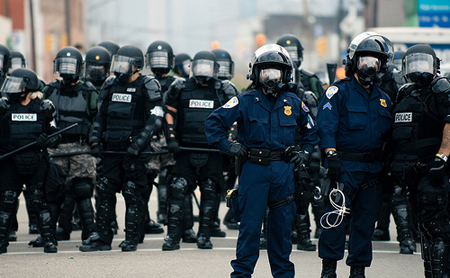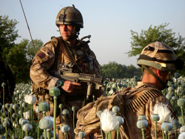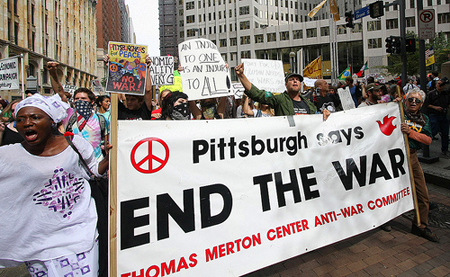Posted September 30, 2009
— Jonah McAllister-Erickson
Activist with the Thomas Merton Center (writing in a personal capacity)

Afghanistan:
The Case for Out Now

Read the new statement by the Solidarity Political Committee on the case for immediate withdrawal from Afghanistan, issued on the day the occupation entered its ninth year.
Check back in the upcoming days for reports on the October 17 mobilizations on the Solidarity Webzine. For more information about Solidarity’s perspectives and work in the anti-war movement, email info@solidarity-us.org.
On September 24th and 25th, the heads of state, finance ministers and central bankers that make up the Group of 20 (G-20) met in Pittsburgh. Over the duration of the summit, the city went into lockdown. Some 4,000 police officers and 2,000 members of the Pennsylvania National Guard laid siege to the city in the name of “protecting” the summit. A twelve-foot tall steel wall was erected a half mile away from the convention site, and nearly a dozen heavily armed coast guard vessels patrolled the city’s three rivers.
In a domestic first, the police deployed the Long Range Acoustic Device (LRAD), a machine that emits an earsplitting noise that can reach up to 150 decibels, intended to subdue or disperse crowds and capable of causing permanent hearing damage. LRAD weapons have previously been rolled out by the U.S. military in Somalia and Iraq, and are now being put to use by the Honduran right against the resistance to the coup. As the G-20 summit brought together the leading figures of the international ruling class, the new forms of repression against the protests at the G-20 brought together disparate strands of resistance—albeit in a deeply unpleasant and unexpected way.
Specter of Repression
In an attempt to whip a climate of fear and paranoia, city leaders dragged out implausible and now all-too familiar canards prior to the demonstrations: for instance, that protestors were stockpiling an arsenal of feces and urine and were responsible for burglaries across Pittsburgh. At the same time, the government ignored, delayed or denied dozens of permit requests for activities ranging from educational tent cities to protest marches.
Faced with a city government more intent on demonizing than at least grudgingly tolerating dissent, several activist groups banded together and filed a lawsuit to secure our rights to assemble and stage peaceful protests and educational activities.
In the days leading up to the summit, the police continually harassed the Three Rivers Climate Convergence and the Seeds for Peace Collective, conducting illegal searches, impounding vehicles, and confiscating property set up for permitted educational activities.
Wave of Resistance
With the specter of massive state repression hanging in the air, the week’s demonstrations began with a banner drop by Greenpeace activists, and a self-policed rally and concert organized by the Blue Green Alliance, a project initiated by the United Steel Workers and the Sierra Club. These actions followed the People’s Summit, a weekend long counter-summit featuring both local organizers and internationally recognized figures of the left such as Howard Zinn and Walden Bello, garnering favorable and sympathetic coverage in local media.
On Thursday, Sept. 24, around 1,000 protestors were brought together by the self-described anarchist/anti-authoritarian Pittsburgh G-20 Resistance Project, for the People’s Insurrection, which aimed to disrupt the actual proceedings of the G-20 summit.
The PG20RP—believing that seeking permission to demonstrate was disempowering and thus not having acquired permits—faced off with the full force of the police in Arsenal Park in downtown Pittsburgh. After a short standoff, demonstrators moved out of the park and marched several blocks before being confronted by another police blockade.
At the very moment President Obama arrived in Pittsburgh, police announced that the march was illegal and gave an order to disperse. Most of the demonstrators retreated, and police then descended upon those who remained, subjecting them to the full gauntlet of OC gas, smoke, and concussion grenades. It was here that LRAD weapons made their first appearance. The resulting melee resulted in 13 arrests, and several smashed windows.
That evening, hundreds of protestors, counter-protestors, and curious students gathered in Schenley Plaza, the “grand entrance” to Schenley Park, surrounded on three sides by the campus of the University of Pittsburgh. Inside of Schenley Park, President Obama was hosting the opening gala for the G-20 at the Phipps Conservatory.
After allowing them to use the park for several hours without incident, police converged on the site. They arbitrarily declared the gathering an unlawful assembly and indiscriminately arrested 42 protestors, bystanders, and counter-protestors, while again using the full array of weapons to scatter the crowd.
At Noon on Friday, Sept. 25, activists from all wings of the anti-G20 movement assembled for the Peoples’ March, a peaceful and permitted demonstration organized by the Thomas Merton Center, and endorsed by over 70 local and national organizations.

Every stop of the march was subject to intense police provocation, beginning with their failure to block traffic at our appointed assembly point, forcing the marshals to shut down the road ourselves. Cops lined the side of the streets in full riot gear—with many on horseback—and motorcycles rumbled through the periphery of our demonstration with no explanation.
The Thomas Merton Center estimated that around 8,000 people joined the demonstration. At one point, KDKA, the local CBS affiliate, quoted the crowd as 10,000 strong, making it one of the biggest marches in Pittsburgh since the movement against steel mill closures in the 1980s, and by far the largest demonstration to have such radical demands as: Money for Human Needs, Not for Wars and Occupations – Environmental Justice for the Earth and its Inhabitants – Jobs and Health Care for All.

In response to this confident and large demonstration, the police were clearly looking for a fight. On Friday evening, hours after the last delegate had left Pittsburgh, as the barricades around the convention center were being dismantled, police engaged in their most unwarranted and aggressive act of repression.
Hundreds of people had again gathered in Schenley Plaza: some coming for a rumored concert, and other brought there by a flyer announcing a protest of the previous night’s police brutality.
At 10:30 pm, after surrounding the plaza, the police announced that the gathering was illegal and ordered the crowd to disperse. As the crowd attempted to leave Schenley Plaza, they were met by more police converging from all directions. A group of protestors joined by others attempting to escape the enclosing police lines ran up Bellefield Ave., only to be met by yet more police, and were forced to jump over a fence and bushes to get into the Cathedral of Learning lawn, where they were forced to the ground and eventually arrested. This is where the majority of arrests occurred.
Among this group was Pete Shell, the co-chair of the Thomas Merton Center Anti-War Committee, who said, “We tried going left, we tried going forward, we tried going right. We wanted to disperse and they did not let us disperse.” Also arrested on the cathedral lawn was Sadie Gurman of the Pittsburgh Post-Gazette. She recounted, “Some of the girls were hugging each other and crying, saying to the police, ‘Tell us how we can get out of here peacefully. We don’t want to be here, but you’ve trapped us.’”
After this, the police went on a rampage through the streets of Oakland on the University of Pittsburgh campus, shooting students and community members with rubber bullets and bean bag rounds. One victim was Nathan Lanzendorfer, who said, “I never heard any warning to leave the area—all four [rubber bullet] shots were within five seconds. All the wounds are on my back. If I was opposing [the police] at all, you’d think I’d have a front wound.”
The police also released OC Vapor into the main undergraduate dormitory at Pitt, The Towers, forcing hundreds of students to flee for their safety. At one point an officer entered the lobby and said, “This is not martial law, but almost just like it.” Dozens of students were beaten, pepper sprayed, and terrorized.
Heartwarmingly, the police were able to take a break from beating protestors to pose for a picture with one of the arrestees.
A Grassroots Response
The local activist community has mobilized in response to this unconscionable police violence.
A defense fund and organization is being organized, through the Thomas Merton Center, with the PG20RP and other forces, for all those arrested during the G20. More information will be available on this soon.
The most exciting development has been spontaneous organizing among local college students in response to the invasion of their campuses. On Monday afternoon, a group of students met to discuss what happened on Friday and marched to the Chancellor’s Office to demand that the University Administration stand up for students’ rights and that no students be punished by the University as a result of the G-20 arrests. On Monday evening another meeting was organized on campus, and it was decided that a speak out and demonstration be held this Thursday at 5:15 pm, at the corner of Forbes and Bigelow. The demonstration is permitted.
A Facebook group called “Hold The Police Accountable Oakland G20” has been formed and already has over 800 members, and a website has been set up to chronicle what happened to the community with lots of links and more Facebook groups one can join.
In response to this initial organizing, the University has backed away from its initial plan to send all students arrested during the G-20 to the Judicial Board with the possibility of expulsion or a lesser punishment, and is now formulating a new plan. Also the District Attorney’s office has already announced that charges will be dropped against four Pitt students.
